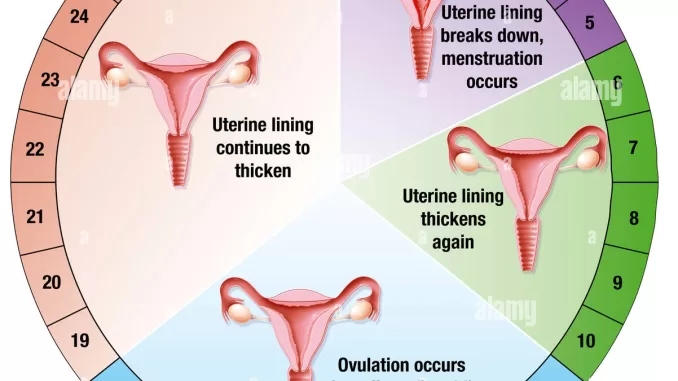
The menstrual cycle is a series of natural body changes a woman undergoes each month in preparation for pregnancy. Each month the ovary releases an ova or egg a process known as ovulation, in turn, the body releases hormones that prepare the uterus lining for pregnancy. If fertilization has not taken place, the uterus lining is shed off through the vagina during the menstrual period. The menstrual cycle is different in each individual. The cycle is counted from the first day of one’s period to the first day of the next. Menstrual bleeding occurs every 21 – 35 days lasting for about 2 – 7 days. Menstruation begins from puberty till menopause.
menstrual cycle Phases.
- Menses phase- characterized by the occurrence of the shedding of the uterus lining when fertilization does not occur. The menstrual period may last for about 3- 7 days.
- Follicular phase- estrogen hormone level rises causing the endometrium to grow and thicken. The follicle-stimulating hormone (FSH) makes the follicles in the ovary grow and one of the developing follicles forms an ovum.
- Ovulation phase- the level of luteinizing hormone (LH) increases causing the ovary to release the ova.
- Luteal phase- the ovary releases the ova which passes through the fallopian tube to reach the uterus. Progesterone hormone level rises in preparation of the uterine wall for pregnancy in case fertilization occurs. If fertilization occurs, the egg attaches itself to the uterine wall. When fertilization does not occur the level of estrogen and progesterone drops thus making the lining of the uterus shed.
Signs of menstrual.
- Mood changes.
- Stomach bloating.
- Tenderness of the breast.
- Food craving.
- Some people have acne.
- Headache.
Causes of menstrual irregularities.
- Breastfeeding can delay the return of periods.
- Uterine fibroids can cause long and heavy menstrual periods.
- Pelvic inflammatory diseases.
- Eating disorders such as anorexia.
- Having polycystic ovary syndrome.
- The loss of typical ovarian function also known as premature ovarian failure.
Menstrual irregularities can be treated using birth control that contains progestin. Progestin does not only make periods light but also makes cramping less painful.
How to track your menstrual cycle
Period tracking is important as it helps you prepare if you plan to get pregnant. To track the period one needs to:
- On the first day of the period, mark the calendar with a tick(✔).
- Continue marking the calendar each day till the period stops.
- Do the same for a number of months.
- Count the number of days between each first tick to get the length of the cycle and the number of tick’s each month to see the number of days bleeding occurs.
Menstrual problems.
- Heavy menstrual bleeding which if left untreated may cause anemia.
- The absence of the menstrual period is also known as amenorrhoea. It this abnormal for a female of reproductive age not to have periods unless one is pregnant, breastfeeding, pre-puberty, or one is post-menopause.
- Dysmenorrhoea – also known as painful menses characterized by cramps.
- Premenstrual syndrome is where one experiences mood changes just before the onset of the period. They include fatigue, headache, craving, etc.
- Bay head elementary school history, enrolment, programs offered.
- How is The Lenana Boy school and location?
- List of Accredited Private Universities in Kenya
- Kenya Institute of special education, courses.
- The best private primary schools in Nyeri county.
- List of best private primary schools in Kirinyaga County.
- Mount Kenya University history, fees, courses